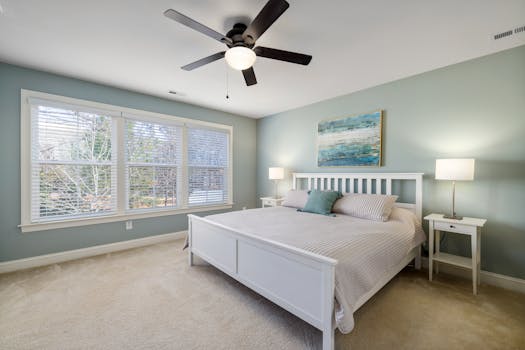Ceiling Fan Direction Myth: Does It Really Matter?

Ceiling Fan Direction Myth: Does It Really Matter?
You’ve probably heard the advice: switch your ceiling fan direction to counterclockwise in summer and clockwise in winter to save energy and stay comfortable. But is this a game-changer, or just a ceiling fan direction myth? With searches like ceiling fan direction summer and does reversing a ceiling fan really work trending, it’s time to set the record straight. In this post, we’ll debunk misconceptions about ceiling fan clockwise vs counterclockwise, explore the science behind fan direction, and share tips to optimize your home’s comfort. Let’s clear the air on this household myth!
The Origins of the Ceiling Fan Direction Myth
Where Did This Myth Come From?
The idea of changing ceiling fan direction for seasons emerged in the 1980s, when energy efficiency became a focus during the U.S. energy crisis. Manufacturers like Hunter promoted reversing fans to redistribute heat in winter, claiming significant savings. By the 2000s, home improvement blogs and X posts (e.g., ceiling fan direction myth reddit) exaggerated these benefits, suggesting reversing fans could slash heating bills. Globally, similar advice appears in countries like Australia, where fans are common, but the impact is often overstated.
Why It Persists
The myth thrives because ceiling fans are ubiquitous—70% of U.S. homes have them, per the Department of Energy (DOE)—and we love simple energy hacks. Questions like how to tell if a ceiling fan is in winter mode or what is the best fan direction to cool a room reflect our desire for easy fixes, even if the benefits are modest.
Myth 1: Reversing Ceiling Fans Saves Major Energy
Does Reversing a Ceiling Fan Really Work?
Does reversing a ceiling fan really work? Yes, but the savings are modest. In summer, ceiling fan direction for cooling (counterclockwise) creates a breeze, making rooms feel 4–6°F cooler, per the DOE. In winter, ceiling fan direction for winter (clockwise at low speed) pushes warm air down from ceilings. However, a 2023 University of California study found winter mode saves only 1–2% on heating bills in well-insulated homes. The myth overstates the impact, especially with modern HVAC systems.
How It Works
Ceiling fan clockwise vs counterclockwise: Counterclockwise creates a downward breeze for cooling; clockwise circulates warm air trapped near ceilings. What are the benefits of reverse fan? Improved comfort and minor energy savings, but not a heating revolution.
Myth 2: Fan Direction Is Critical for Comfort

What Is the Best Fan Direction to Cool a Room?
What is the best fan direction to cool a room? Counterclockwise in summer, per the DOE, as it maximizes airflow. Which way to run a ceiling fan with AC? The same—counterclockwise enhances AC’s cooling effect, reducing runtime by ~5%, per a 2024 Energy Star report. However, the myth that direction is make-or-break ignores room size, insulation, and fan quality (e.g., 3 blade ceiling fan vs. 72 inch ceiling fan).
Winter Mode Nuances
Why reverse fans in winter? Clockwise motion redistributes heat, but impact varies. How to tell if a ceiling fan is in winter mode? Check for upward airflow (gentle updraft) at low speed. If your home has high ceilings, the effect is stronger; in low-ceiling rooms, it’s minimal, per ASHRAE.
Myth 3: Changing Fan Direction Is Complicated
How to Change Ceiling Fan Direction
How to change ceiling fan direction? It’s simple—most fans have a switch on the motor housing or a remote setting, per Hunter’s 2025 manuals. Which way is clockwise on a ceiling fan? Facing up, blades spin right (clockwise) for winter; left (counterclockwise) for summer. The myth that it’s complex stems from outdated fans without clear controls.
Modern Fan Features
Today’s ceiling fans with LED lights or ceiling fan down rod models make switching easy. Garage ceiling fan or windmill ceiling fan designs often include remotes, debunking the hassle myth. Check your manual or look for a switch above the blades.
Practical Tips for Optimizing Ceiling Fan Use
Maximizing Comfort and Efficiency
- Set the right direction: Use ceiling fan direction summer (counterclockwise) for cooling; switch to ceiling fan direction for winter (clockwise) for heat circulation.
- Adjust speed: Low speed in winter, medium-high in summer, per DOE.
- Pair with HVAC: Run fans with AC or heat to boost efficiency, saving ~3–5% energy, per Energy Star.
- Upgrade fans: Choose ceiling fans with LED lights or larger ceiling fan dimensions (e.g., 72 inch ceiling fan) for better airflow.
Avoiding Pitfalls
Don’t expect fans to replace AC or heaters—ceiling fan direction myth reddit threads often overhype savings. Clean ceiling fan blades regularly to maintain efficiency, and avoid outdated brass ceiling fan models with poor motors.
Conclusion
The ceiling fan direction myth overstates the magic of switching your fan’s direction—ceiling fan direction summer and ceiling fan direction for winter help, but they’re not energy game-changers. Does reversing a ceiling fan really work? Yes, for comfort and minor savings, but modern HVAC outshines fans. Use the right direction, optimize settings, and enjoy a cozier home. Got a home myth to bust? Share below and join OmniMyths for more practical truths!
Frequently Asked Questions
Q: Does reversing a ceiling fan really work?
A: Yes, reversing to clockwise in winter pushes warm air down, and counterclockwise in summer cools, per DOE. Savings are modest—1–2% on heating, 3–5% with AC.
Q: How to tell if a ceiling fan is in winter mode?
A: Check for a gentle updraft (clockwise, low speed), pushing warm air down. Look for a switch on the fan or remote, per Hunter manuals.
Q: What is the best fan direction to cool a room?
A: Counterclockwise creates a cooling breeze, enhancing AC efficiency, per Energy Star. Use medium-high speed for best results in summer.
Q: Why reverse fans in winter?
A: Clockwise motion circulates warm air trapped near ceilings, improving comfort, per ASHRAE. It’s most effective in rooms with high ceilings.
Q: Which way to run a ceiling fan with AC?
A: Run counterclockwise to boost cooling airflow, reducing AC runtime by ~5%, per 2024 Energy Star data. Ensure medium-high speed for optimal effect.
Q: Does ceiling fan direction really matter?
A: Direction matters for comfort—counterclockwise cools, clockwise warms—but savings are small, per UC studies. Insulation and HVAC are bigger factors.